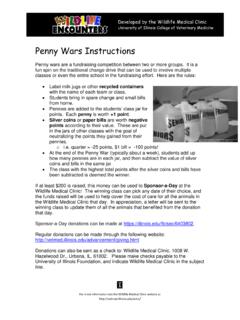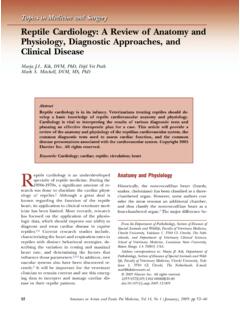Transcription of Tobias Portosystemic shunts - University of Illinois ...
1 Portosystemic shunts Karen M Tobias , DVM, MS, Diplomate ACVS Professor, Small Animal Surgery University of Tennessee, Knoxville TN pathophysiology of PSS Portosystemic shunts (PSS) are abnormal connections between the portal system (splenic, phrenic, cranial mesenteric, caudal mesenteric, gastric, or gastroduodenal veins) to the caudal vena cava or azygos vein. Congenital intrahepatic PSS result from persistence of the ductus venosus or form during fetal development of hepatic sinusoids and portal vessels. They are usually found in large and medium sized breeds of dogs, such as Irish wolfhounds, Labrador retrievers, old English sheepdogs, and Australian shepherds. They have also been reported in some cats and in small breeds, particularly miniature poodles. Single congenital extrahepatic Portosystemic shunts connect the portal vein or one of its tributaries to the caudal vena cava or the azygos vein.
2 They are usually found in small breed dogs, such as pugs, schnauzers, Maltese, Shih tzus, and especially Yorkshire terriers, and are the most common type of congenital shunt in cats. They have also been reported in large breed dogs. Extrahepatic multiple acquired Portosystemic shunts connect the portal tributaries to the caudal vena cava, usually near the renal veins. They occur as a result of end stage liver disease (cirrhosis) and portal hypertension. These abnormal vessels are present microscopically in normal dogs and will enlarge when portal pressure becomes too high for the portal system to tolerate. They are not surgically correctable. Congenital portal vein hypoplasia (PVH) with secondary microvascular dysplasia (MVD) has occasionally been called microscopic intrahepatic shunts . The condition MVD is actually a pathologic change and can have many underlying etiologies ( noncirrhotic portal hypertension, congenital PSS, congenital portal vein hypoplasia).
3 Most commonly, this condition results from congenital portal hypoplasia (PVH), in which microscopic portal vessels are underdeveloped or absent at birth. Unfortunately, PVH occurs in the same breeds that are commonly affected with congenital extrahepatic PSS (Maltese, Yorkies, Cairn terriers, etc.) and can cause clinical signs and blood work changes similar to PSS, though usually to a lesser extent. This condition is not surgically treatable. Clinical Signs and Laboratory Abnormalities Clinical signs of PSS result from abnormalities of the nervous system, urinary tract, and digestive system. General signs in dogs and cats include poor weight gain, stunted growth, and poor recovery from barbiturate anesthesia . Cats often hypersalivate. Neurologic abnormalities are most common, particularly behavioral changes, depression, disorientation, seizures, blindness, and ataxia.
4 Seizures are seen in over 65% of cats. Some older dogs may only present with signs of cystitis or urinary tract obstruction (dysuria, pollakiuria, hematuria, stranguria) from urate calculi and ammonium biurate crystals. Gastrointestinal signs include vomiting and diarrhea. Ascites is very uncommon in animals with congenital PSS and is usually an indication of multiple acquired shunts . It may also occur with severe hypoalbuminemia. Clinical signs of hepatic encephalopathy include dementia, stupor, seizures, tremors, and coma and are caused by increased sensitivity to toxins and drugs. Ammonia and other toxins are produced from protein breakdown in the colon. Hepatic encephalopathy can be precipitated by high protein meals, intestinal hemorrhage (such as from parasites), transfusion with stored blood, infection, constipation, and drugs such as anesthetics, analgesics, and tranquilizers.
5 Severe hepatic encephalopathy should be treated with intravenous fluids, warm water enemas, antibiotics ( , neomycin, amoxicillin, or metronidazole), and lactulose by mouth or per rectum. Laboratory abnormalities include changes in the complete blood count (CBC), biochemistries, and urinalysis. On CBC, microcytic anemia may be present. Decreases in blood urea nitrogen and albumin are common in dogs, and glucose may be low. Liver enzymes may be increased, especially in cats. Urine specific gravity is often decreased, and ammonium biurate crystals may be seen in the urine sediment (400X magnification). Serum bile acid concentrations are increased because of poor liver function. Fasting bile acids are less than 5-15 mol/L in normal dogs and are greater than 25 mol/L in 95% of dogs with shunts . Bile acids measured 2 hours after a meal are usually greater than 75 mol/L in dogs with PSS; however, one study found that over 10% of dogs with PSS had fasting and fed bile acids of 25 mol/L or less.
6 Some normal Maltese may have falsely elevated bile acids because of a chemical that interferes with spectrophotometry. Ammonia tolerance tests can also be used to diagnose liver dysfunction, since NH3 is increased in 90% to 100% of dogs with PSS. Liver biopsy results include atrophy, decreased numbers of portal tributaries, and proliferation of arterioles and bile ductules. These results may also be present in dogs with PVH/MVD. Diagnosis of Portosystemic shunts Increased bile acids or ammonia or presence of ammonium urate crystals in a puppy with clinical signs of hepatic encephalopathy is suggestive of Portosystemic shunting. On plain abdominal radiographs, a small liver may be seen. Animals with shunts may also have large kidneys or calculi in the bladder or kidneys (urate stones are usually radiolucent but will be radio-opaque if they also contain struvite).
7 shunts may be detected during ultrasound examination of the abdomen; intrahepatic shunts are easier to find with ultrasound because they are very large. Even if the shunt is not visualized on ultrasound, other clues may be found, including sediment in the kidneys and bladder, increased kidney size, decreased portal vein size (if there is a congenital extrahepatic shunt ), and turbulent blood flow. Another method for detecting shunting is to inject agitated saline into the spleen and to simultaneously ultrasound the right atrium or distal caudal vena cava for air bubbles. Portograms provide diagnosis and location of shunts in all animals. Radio-opaque, sterile, water soluble contrast is injected into a catheterized jejunal or splenic vein (maximum total dose, 2 ml/kg). Radiographs (left lateral is best) are taken 1-3 seconds after beginning the injection, or continuously if a fluoroscope is available.
8 A direct injection of the spleen can also be performed; however, less contrast reaches the shunt quickly and contrast that remains in the spleen may obscure the shunt itself. Diagnosis can also be made with nuclear scintigraphy. Trans-splenic scintigraphy (injection directly into the spleen) provides a portogram in some animals, and in about 70% of animals allows differentiation between multiple extrahepatic and single congenital PSS. An overnight stay is required because animals are radioactive after the procedure. The gold standard for shunt diagnosis is dual phase computed tomographic angiography, which allows reconstruction of the vessels and identification of vessel number, location, and termination. Differential Diagnoses Any liver disease can cause bile acids and ammonia to increase. Dalmatians and other breeds can have urease deficiencies that result in production of ammonium biurate crystals.
9 Hepatic encephalopathy must be differentiated from distemper, hydrocephalus, hypoglycemia, toxicities, and epilepsy . PVH/MVD causes the same clinical signs and laboratory and biopsy changes as extrahepatic congenital Portosystemic shunts ; however, results of advanced imaging techniques are normal. Dogs with acquired multiple extrahepatic shunts may have ascites and coagulation abnormalities. In these dogs, coagulation should be checked before taking a liver biopsy. Medical Management of Portosystemic shunts Dogs with neurologic signs should be placed on intravenous fluids with dextrose and given an enema with warm water and lactulose. Seizures are initially treated with diazepam or another benzodiazepine, and the animals are placed on levetiracetam. A protein-restricted, highly digestible liver diet is essential for all animals with PSS.
10 Dogs with shunts need at 2 gm protein/kg body weight (higher than the protein content in many kidney diets). Hill s L/D and Royal Canine Hepatic are excellent prescription diets; if additional protein is desired, the owners can add a couple of teaspoons of yogurt with active cultures. Lactulose syrup decreases ammonia production and absorption by acidifying the colon and acting as a cathartic. Oral antibiotics (neomycin or metronidazole) help to control clinical signs if diet and lactulose are not enough. Intestinal parasites and gastrointestinal bleeding are treated to reduce protein in the intestines and improve the animal s health. Nutriceuticals (denosyl [SAM-e] and milk thistle [Marin, Denemarin]) may improve hepatic regeneration and detoxification; veterinary formulations are recommended since many of the over-the-counter brands do not actually contain a sufficient amount of active ingredients.






